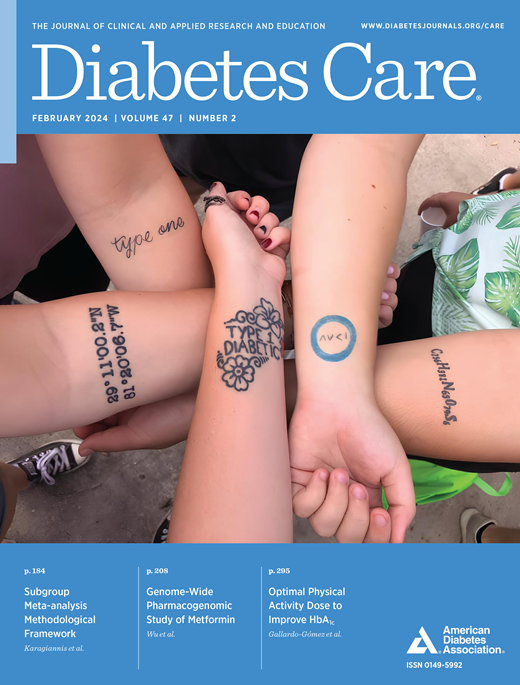Trends in Cystic Fibrosis–Related Diabetes Epidemiology Between 2003 and 2018 From the U.S. Cystic Fibrosis Foundation Patient Registry
IF 16.6
1区 医学
Q1 ENDOCRINOLOGY & METABOLISM
引用次数: 0
Abstract
OBJECTIVE A number of disease-modifying therapies have been introduced for people with cystic fibrosis (CF) over the past two decades. The cumulative effects of this changing landscape on CF–related diabetes (CFRD) are unclear. We examined trends in CFRD epidemiology over time using data from the U.S. Cystic Fibrosis Foundation Patient Registry (CFFPR). RESEARCH DESIGN AND METHODS CFFPR data from 2003 to 2018 were queried to determine annual screening, incidence, and prevalence rates of CFRD. Individuals with incident CFRD were compared with individuals without CFRD. Survival analyses were performed to estimate the cumulative hazard of CFRD given predictors of interest over the 15 years of study. Data were also grouped into three time periods (2003–2008, 2009–2013, and 2014–2018) to investigate whether the hazard of developing CFRD varied over time. RESULTS CFRD screening rates increased from 2003 to 2018, particularly in 10- to 18-year-olds. Although screening rates increased in adults, overall rates remained low. In 10- to 18-year-olds, the incidence of CFRD was stable over time, while incident cases in adults steadily decreased, approaching incident rates in adolescents. Despite this, the prevalence of CFRD has gradually increased in adults, likely reflecting increased longevity. Age, female sex, Black race, severe mutation class, liver disease, poorer lung function, pancreatic insufficiency, enteric feeds, and low and high BMI were all risk factors associated with CFRD. CONCLUSIONS Findings support the need for the development of tailored CFRD screening algorithms and increased subspecialists to care for a growing population of adults with CF and CF-associated comorbidities.来自美国囊性纤维化基金会患者登记处的2003年至2018年囊性纤维化相关糖尿病流行病学趋势
在过去的二十年中,许多疾病改善疗法被引入囊性纤维化(CF)患者。这种变化对cf相关性糖尿病(CFRD)的累积影响尚不清楚。我们利用美国囊性纤维化基金会患者登记处(CFFPR)的数据,研究了CFRD流行病学随时间的趋势。研究设计和方法查询2003年至2018年cfpr数据,以确定CFRD的年度筛查、发病率和患病率。将发生CFRD的个体与未发生CFRD的个体进行比较。在15年的研究中,采用生存分析来估计CFRD的累积危害。数据还分为三个时间段(2003-2008年、2009-2013年和2014-2018年),以调查发生CFRD的风险是否随时间而变化。结果从2003年到2018年,CFRD筛查率有所上升,特别是在10至18岁的人群中。虽然成人的筛查率有所增加,但总体比率仍然很低。在10至18岁的青少年中,CFRD的发病率随着时间的推移保持稳定,而成人的发病率稳步下降,接近青少年的发病率。尽管如此,CFRD在成人中的患病率逐渐增加,这可能反映了寿命的延长。年龄、女性、黑人、严重突变类型、肝脏疾病、较差的肺功能、胰腺功能不全、肠道喂养、低和高BMI都是与CFRD相关的危险因素。结论:研究结果支持开发量身定制的CFRD筛查算法和增加亚专科医生的需求,以照顾越来越多的患有CF和CF相关合并症的成年人。
本文章由计算机程序翻译,如有差异,请以英文原文为准。
求助全文
约1分钟内获得全文
求助全文
来源期刊

Diabetes Care
医学-内分泌学与代谢
CiteScore
27.80
自引率
4.90%
发文量
449
审稿时长
1 months
期刊介绍:
The journal's overarching mission can be captured by the simple word "Care," reflecting its commitment to enhancing patient well-being. Diabetes Care aims to support better patient care by addressing the comprehensive needs of healthcare professionals dedicated to managing diabetes.
Diabetes Care serves as a valuable resource for healthcare practitioners, aiming to advance knowledge, foster research, and improve diabetes management. The journal publishes original research across various categories, including Clinical Care, Education, Nutrition, Psychosocial Research, Epidemiology, Health Services Research, Emerging Treatments and Technologies, Pathophysiology, Complications, and Cardiovascular and Metabolic Risk. Additionally, Diabetes Care features ADA statements, consensus reports, review articles, letters to the editor, and health/medical news, appealing to a diverse audience of physicians, researchers, psychologists, educators, and other healthcare professionals.
 求助内容:
求助内容: 应助结果提醒方式:
应助结果提醒方式:


